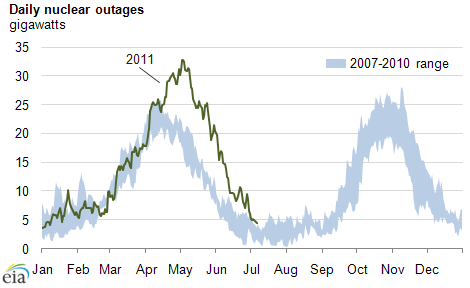
Nuclear power plant outages above seasonal norm in spring of 2011

Note: Scheduled outages start when a unit's reported output drops below 100% and end when it returns to 100%.
Download CSV Data
Like most electric generators, nuclear reactor operators typically schedule maintenance in the spring and the fall to help ensure that the reactors are available to meet peak electric demand in the summer and winter. (See previous nuclear refueling outage story.) The spring of 2011 refueling season coincided with several forced outages and weather-related decreases in capacity availability.
The chart shows total daily nuclear unit outages for 2011 as well as the range of outages between 2007 and 2010 based on data available from the U.S. Nuclear Regulatory Commission (NRC). Total nuclear outages were higher in 2011 than any of the previous four years for much of April, May, June and into July.
Non-refueling outages included other planned maintenance outages and forced outages. The industry marked a ten-year high in total outages in early May 2011 with the loss of Tennessee Valley Authority's three Browns Ferry units (almost 3.5 gigawatts) due to tornado damage to transmission lines serving the plant. The Browns Ferry units remained below full capacity through May 28. Outages of Tennessee Valley Authority plants accounted for 11% of total outages during April through June.
While nuclear units are down, system demand must continue to be met through other sources, usually at a higher operating cost. The PJM region's 16 nuclear plants accounted for 22% of total nuclear plant outages between April and June. Day-ahead spot electric power prices averaged $56.58 per megawatt hour (MWh) in PJM West during April through June of 2011 compared to an average price of $52.61 per MWh during the same time period between 2007 and 2010.